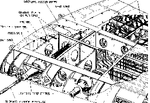"A six 20 mm upgrade for the P-47 would therefore have more worse tradeoffs than benefitials, except for the use as specialized ground attack plane."
I thought it was clear that that was what we were talking about.
Since the P-47 did just fine in the air to air role with eight .50's, (Almost all of the other fighters in the U.S. arsenal did fine with six .50's.) an outfit of six 20's would have been an improvement for the air to ground role which the P-47 assumed heavy responsibility for later in the war.
Anyway, in light of the little Hurricane's ability to handle the recoil of four 20mm's, it wouldn't have been difficult for the P-47 to have handled six. The trade off in increased weight on performance would have been a benefit in the air to ground role.
R988 has an interesting take as well. Perhaps some mix of cannon and machine gun.
It was no engineering feat to make the Hurricane (originally designed to be outfitted with .303 guns) work with four 20mm's. Any re-engineering, if required per your opinion, would have been easily effected. There aren't any fuel tanks in the wings of the P-47D.
I thought it was clear that that was what we were talking about.
Since the P-47 did just fine in the air to air role with eight .50's, (Almost all of the other fighters in the U.S. arsenal did fine with six .50's.) an outfit of six 20's would have been an improvement for the air to ground role which the P-47 assumed heavy responsibility for later in the war.
Anyway, in light of the little Hurricane's ability to handle the recoil of four 20mm's, it wouldn't have been difficult for the P-47 to have handled six. The trade off in increased weight on performance would have been a benefit in the air to ground role.
R988 has an interesting take as well. Perhaps some mix of cannon and machine gun.
It was no engineering feat to make the Hurricane (originally designed to be outfitted with .303 guns) work with four 20mm's. Any re-engineering, if required per your opinion, would have been easily effected. There aren't any fuel tanks in the wings of the P-47D.

